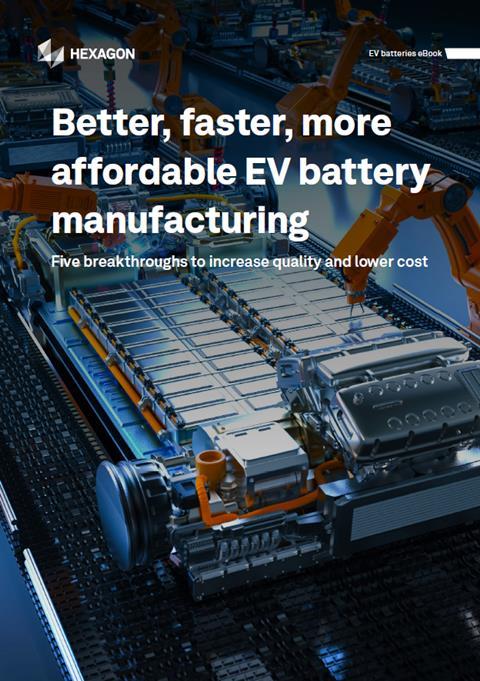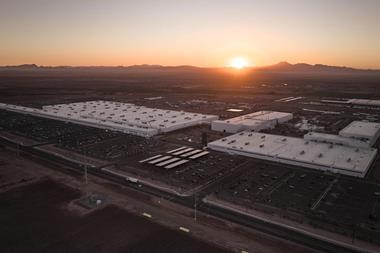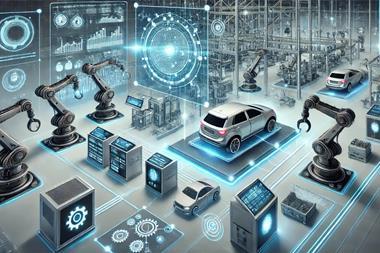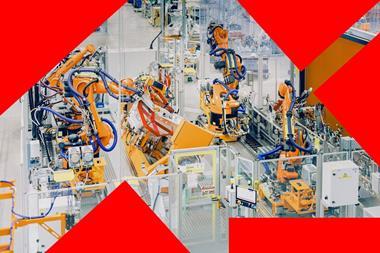A new eBook from Hexagon examines how AI and smart factories are revolutionising EV battery manufacturing, helping Europe and North America catch up with China.

As the automotive industry scales EV production, especially in Europe and North America, original equipment manufacturers (OEMs) and their suppliers face critical challenges. Hexagon has created an eBook, Better, faster, more affordable EV battery manufacturing that examines the technical challenges and explores how emerging technologies like artificial intelligence (AI) and smart factory environments can support battery manufacturing operations.
Scaling battery production – A steep learning curve
European and North American vehicle makers have, until now, been leaders in automotive manufacturing. However, the story is quite different when it comes to EV battery production. Discussing the new eBook and why a resource like this is needed, Hexagon’s Automotive Industry VP Ignazio Dentici points to some of the big challenges the industry faces, and some of the solutions available. He observes that the West, particularly Europe, is lagging behind China in scaling battery production.

“In China, battery production has been in development for years, and their pilot lines are comparable to full-scale manufacturing in Europe,” Dentici explains. This gap is largely attributed to the lack of historical expertise in battery technology in the West. Unlike motors or power electronics – technologies more familiar to automotive OEMs – the battery is a new product to master, requiring both chemical engineering and advanced manufacturing techniques.
Dentici points out that this lack of experience has created a perfect storm: “The combination of new technology, new components, and the need to meet rigorous automotive production standards makes scaling battery production very challenging.”
The importance of competence building
A key factor in the slow development of EV batteries in Europe is gaining the right competences. As Dentici explains, “Developing the necessary expertise takes time, especially in a field as new as battery technology.” Europe has historically applied traditional automotive development cycles to EV battery production, which has slowed progress.
Chinese companies, by contrast, have been able to shorten their development times considerably. Dentici notes that “the timing applied to develop a battery in traditional OEMs is much longer compared to the development time seen in other parts of the world.” This is partially due to the strict validation, testing, and development standards still prevalent in Europe.
To shorten these delays, Western carmakers are forming joint ventures with battery experts from China and South Korea, such as CATL, Samsung, and LG, to accelerate their learning curves.
The role of digitalisation and AI in battery manufacturing
Although the West faces challenges, there is hope for rapid advancement through the digitalisation of production processes and the adoption of artificial intelligence (AI), and smart manufacturing principles. As Dentici explains, many Western carmakers are now recognising the potential of these technologies to accelerate their progress.
“Digitalisation and AI are no longer optional – they are key assets for improving production efficiency and quality,” says Dentici. He highlights how AI is being used to enhance quality checks in battery production, where even minor defects can have major repercussions on performance and safety, something highlighted in the eBook.
He continues, “The application of AI and other technologies allows for incremental improvements in production efficiency, but if you’re starting with a lower level of technological maturity, you need disruptive changes to catch up. AI can help drive those changes, making processes faster and more reliable.”
Shifting toward virtual prototyping and simulation
One of the most notable developments in battery manufacturing is the increasing reliance on simulation technologies. In the past, physical prototypes were essential for testing new designs. However, the need for speed has driven the industry toward “virtual prototyping,” where AI and high-performance computing play a central role.
“With the rise of AI and simulation technologies, there is less reliance on physical prototypes,” says Dentici. “Instead, companies are using virtual prototyping to run simulations that predict how a battery will perform under various conditions.”
By using real-world data from testing, manufacturers can now simulate complex issues like thermal management, structural integrity, and crashworthiness, allowing for faster iterations and more accurate predictions. This shift-left approach to design reduces the time and cost associated with battery development.
Overcoming manufacturing delays – The need for proactive quality control
In addition to development delays, the manufacturing phase of battery production also presents challenges. As Dentici explains, reaching the necessary key performance indicators (KPIs) for manufacturing, such as minimising scrap rates, can be a long and difficult process.
“At the start of production, companies often struggle with high scrap rates – sometimes as high as 30% – which is far above the acceptable level of 1%,” says Dentici. This problem is compounded by the complexity of manufacturing processes for batteries, which involve chemical, thermal, and structural challenges.
To address this issue, companies are increasingly turning to more advanced quality control systems that can catch defects early in the production process. “By anticipating quality checks earlier in the manufacturing flow, you can prevent larger defects down the line, reducing the amount of scrap and improving overall efficiency,” Dentici explains.

Bridging the gap between engineering and manufacturing
Another area of concern is the disconnect between engineering and manufacturing departments within OEMs. While much has been said about the need for closer cooperation, the reality is that many companies still operate in silos. This lack of integration can lead to inefficiencies, particularly when dealing with new and complex technologies like batteries.
Dentici cites Tesla as an example of a company that has successfully implemented “concurrent engineering,” where different engineering departments work together in real-time to solve problems. “Tesla doesn’t have separate engineering departments – everyone works in the same environment and tackles challenges from multiple angles,” he says. This collaborative approach is essential for addressing the multifaceted issues posed by battery technology, which involves chemical, electrical, and structural engineering.
To help foster this kind of collaboration, Dentici mentions platforms like Hexagon’s Nexus, which provide a single environment for development and cooperation. “Having a unified platform allows for better communication and reduces the time wasted in back-and-forth exchanges between OEMs and their suppliers.”
The future of battery manufacturing – AI and smart factories
Looking ahead, Dentici sees AI playing an increasingly important role in both development and manufacturing. “In development, AI is dramatically speeding up design processes that used to take months and can now be done in a few hours,” he says. “In manufacturing, AI is optimising processes, and in the future, generative AI could be used to create the best possible production methods for batteries.”
In addition to AI, the concept of the smart factory is continuing to develop. “Smart factories are essential for EV and battery production,” Dentici asserts. “The vast amount of data generated during the manufacturing process needs to be processed and analysed in real-time to optimise performance and quality.”
However, he warns against overusing the term. “Smart factory has become a bit of a buzzword,” he says. “What it really means is the ability to apply intelligence to the data you’re collecting and use it to improve your processes.”
The journey to scale battery production for electric vehicles in Europe and North America is still in its early stages, with significant challenges remaining. However, as OEMs adopt new technologies like AI, virtual prototyping, and smart factories, they are beginning to close the gap. By focusing on building competence, fostering collaboration, and embracing digital transformation, the future of EV battery manufacturing looks promising.
Hexagon’s new eBook: Better, faster, more affordable EV battery manufacturing
Find out more here or download for free using the form below.



































